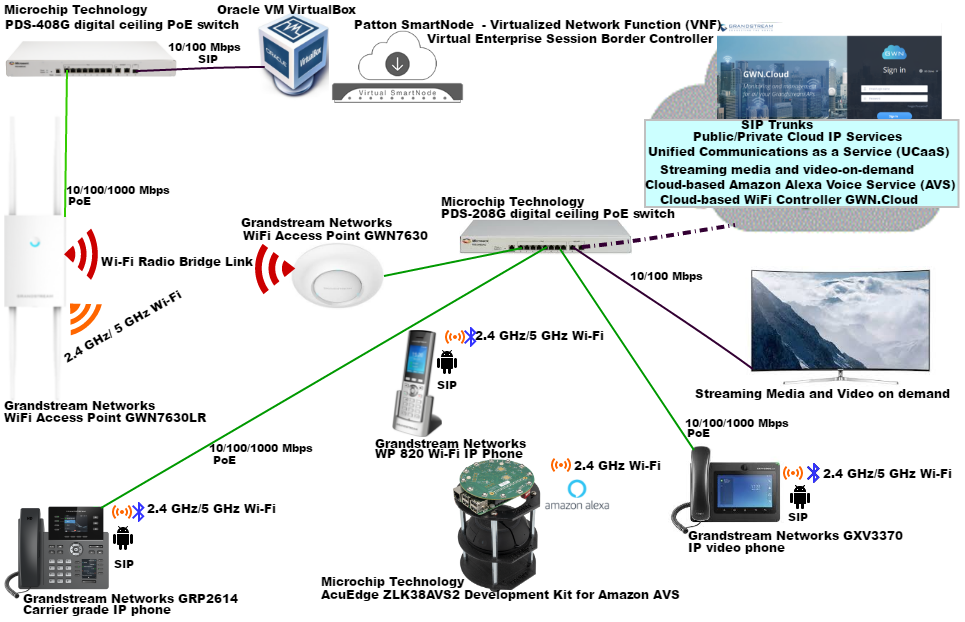Grandstream Networks GWN.cloud
We will now conduct the functional testing of the Grandstream Networks’ GWN7630LR outdoor long-range 802.11ac Wave-2 Wi-Fi access point with the cloud Wi-Fi controller, GWN.cloud. During the testing we will run applications that required high bandwidth and low latency, such as streaming media, video-on-demand, Amazon Alexa Voice Service, real-time voice and video calls.
FUNCTIONAL TESTING
The test setup consisted of Grandstream Networks’ GWN7630LR outdoor long-range 802.11ac Wave-2 Wi-Fi access point running software version: 1.0.13.1 and cloud based Wi-Fi controller, Grandstream Networks’ GWN.cloud software version: 1.0.10.9/GWN.cloud android version:1.0.0.19 and along with the following systems (Please refer Fig.B Functional testing of Grandstream Networks’ GWN7630LR outdoor long-range 802.11ac Wave-2 Wi-Fi access point):
- Microchip Technology PDS-408G Digital Ceiling PoE switch-software release version:1.13 for network connectivity and PoE delivery
- Grandstream Networks GWN7630 802.11ac Wave-2 Wi-Fi access point running software version:1.0.13.1
- Grandstream Networks WP820 Wi-Fi IP phone running software version:1.0.7.7
- Patton Networks’ SmartNode Virtual Enterprise Session Border Controller running software version:3.17.0-20023 on virtualization system/hypervisor Oracle VM VirtualBox software version:6.1.2
- Grandstream Networks GXV3370 IP video phone running software version:1.0.3.3
- Microchip Technology PDS-208G Digital Ceiling PoE switch-software release version:2.53 for network connectivity and PoE delivery
- Grandstream Networks GRP2614 carrier-grade IP phone running software version:1.0.3.6
- Microchip Technology AcuEdge ZLK38AVS2 Front end audio Development Kit for cloud-based Amazon Alexa Voice Service (AVS).
Fig.B Functional testing of Grandstream Networks’ GWN7630LR outdoor long-range 802.11ac Wave-2 Wi-Fi access point
We first mounted and connected the GWN7630LR using the provided installation accessories. Microchip Technology PDS-208G/PDS-408G Digital Ceiling PoE switches provided PoE and network connectivity. Patton networks Virtual SmartNode (vSN) as a Virtual Network Function (VNF) Session Border Controller (SBC), delivered SIP registrar services and SIP demarcation from the public SIP trunk/UCaaS provider in the cloud, while preserving interoperability and interconnectivity. Patton Cloud, a single portal network orchestration tool, was used for its provisioning and management.
We opened a browser and logged into the GWN7630LR (selected log in role as master), the ensuing setup wizard guided us through the basic setup (edited/selected the required values: Country, Time Zone, AP status showed as Master, enable SSID, SSID name, security mode, WPA key mode, WPA encryption type, WPA pre-shared key). Under SSIDs for the previously setup SSID, we edited/selected the required values for- Client bridge support, multicast to unicast, enable Voice Enterprise, enable 802.11r, enable 802.11k, enable 802.11v etc. We then moved to the next item on the menu, listed as access points. There for our APs in the test Wi-Fi network setup we edited/added/selected the correct values and configurations, starting with the GWN7630LR’s Device name, fixed IP, IPv4 address, IPv4 subnet mask, IPv4 gateway, preferred IPv4 DNS, alternate IPv4 DNS, band Steering, client steering, 2.4GHz/5GHz, mode, channel width, active spatial streams, radio power, etc. saved and applied the settings. We clicked on discover AP, paired AP GWN7630 and configured it with the appropriate values for the parameters listed above.
The GWN7630LR was now a member of the dual-band SSID that we created, and its embedded controller function was used to manage the GWN7630 AP and the Wi-Fi network clients. (Refer to Fig. C & Fig. D).

Fig.C Wi-Fi scan showing the dual band SSID 7600 for the created test Wi-Fi network

Fig.D GWN7630LR Status-Master Wi-Fi Controller- Web GUI interface
We switched the Wi-Fi controller role between the APs on the Wi-Fi network. For the GWN7630, clicked on the icon for Transfer to master to designate it as the new master Wi-Fi controller (Refer to Fig. E). and we could also revert it back, by clicking the icon Transfer to master on the GWN7630LR.


Fig.E GWN7630 Status Screen-Transfer to Master Wi-Fi Controller
Validated the client bridge feature, the GWN7630 AP was deployed as a bridge to link the remote ethernet network. The GWN7630 AP status showed client bridge mode = isolated and the remote ethernet segment was bridged over the Wi-Fi connection (Refer to Fig. F)


Fig.F GWN7630 Status-Client Bridge mode
Over the setup dual band Wi-Fi network, we tested- Microchip Technology’s AcuEdge ZLK38AVS2 Front end audio Development Kit connectivity to the cloud-based Amazon Alexa Voice Service (AVS) and SIP registration/connectivity of: the Grandstream Networks GXV3370 IP video phone, Grandstream Networks WP820 SIP Wi-Fi phone and Grandstream Networks GRP2614 carrier grade IP phone. We were successful in registering and placing inbound/outbound voice calls with the ITSP’s external SIP trunk/UCaaS platform in the cloud through the Patton networks Virtual SmartNode(vSN) as a Virtual Network Function (VNF) Session Border Controller (SBC). Matter of fact, over the Wi-Fi network, we were able to run applications that required high bandwidth and low latency, such as real-time voice, video calls, streaming media and video-on-demand.
It was now time for us to transfer the GWN7630LR and the GWN7630 APs to the GWN.cloud. For that we clicked on the Transfer network group button , it allowed us to transfer our local configurations to our cloud account [prompted us to create a network by entering a new network name for the network group) and alternatively if we clicked on Transfer AP button [it would have allowed us to select a pre-existing network group and move our APs in to it] (Refer to screenshot excerpts Fig. G).
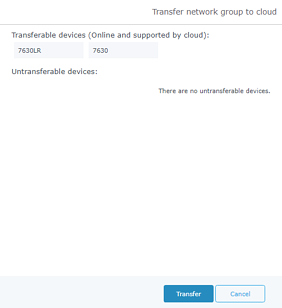
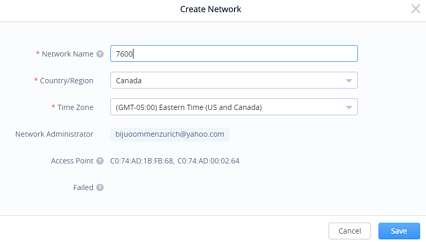
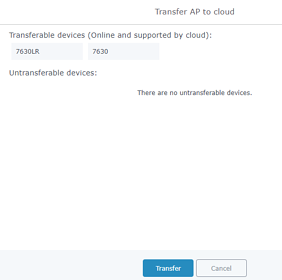

Fig. G GWN7630-Transfer Network Group/Transfer AP Status Screens
We were able to successfully transfer to the GWN.cloud [cloudhosted/CloudSoftware-as-a-Service (SaaS)], using a browser we continued to manage, monitor and report on the Wi-Fi network, access points and the clients. (Refer to Fig. H)
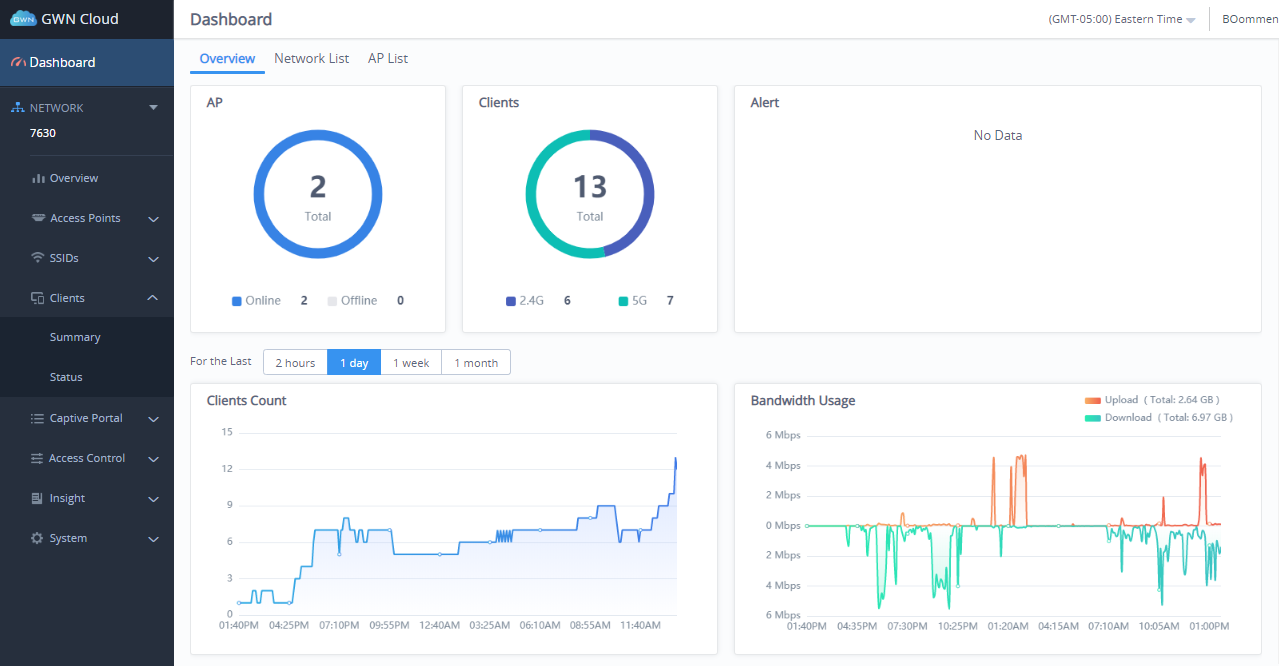
Fig.H GWN.cloud cloud hosted /Cloud Software-as-a-Service (SaaS) Dashboard view
All complex features and functions supported on the GWN7630LR were now available on the web-based management interface. For us, the deployment was simple and straight-forward, just a few clicks away, thanks to the well laid out and intuitive onscreen menu layout. All we needed was a browser and or the GWN.cloud android version running on our smart phone to access the real-time data, status/alerts and report information on our test Wi-Fi network, clients and APs. We could configure and modify GWN7630LR’s functions and features using the web based Grandstream management interface, giving us complete control over the setup Wi-Fi network, access points and clients. The browser interface gave us access to the GWN7630LR unit’s administration, monitoring, reporting and alerting functions.We were up and running expeditiously, using the embedded Wi-Fi controller and the GWN.cloud. It is noteworthy that the migration to the cloud was easy and the functionality testing was a success as everything worked satisfactorily.
Conclusion
Grandstream Networks’ GWN7630LR outdoor long-range 802.11ac Wave-2 Wi-Fi access point is a cost-effective Wi-Fi solution that was very easy to setup as it supports an embedded Wi-Fi controller and the GWN.cloud, a cloud hosted /Cloud Software-as-a-Service (SaaS) platform. We would exhort you to check it out as a part of your improved Wi-Fi wireless strategy for long-range and/or outdoor Wi-Fi deployments, as it offers, a 300-meter range and weatherproof casing.

